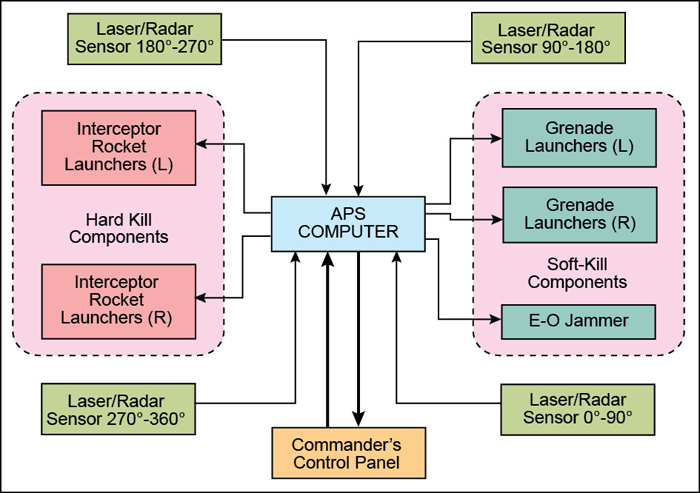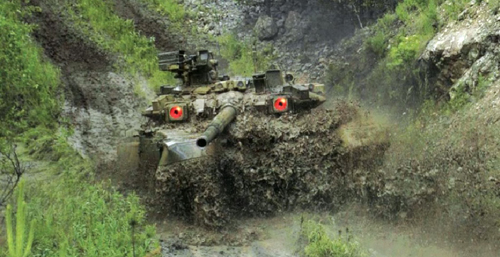Unlike the artillery guns, tanks see their targets and shatter them. During an advance, typically, the tank will put its crosshairs on anything that annoys the advance and blow it into smithereens. If a bunker is annoying the infantry the tank will put it in its crosshairs and shatter it, in what is called ‘direct fire support.’ The shells fired by tanks exit the gun in a flat trajectory at a speed of around 1525 m/s (5000 ft/s) whereas the shells fired from SPGs exit the gun in a parabolic trajectory at a speed of around 305 m/s (1000 ft/s).
The basic differences between a tank and an SPG make them to complement each other. In an armoured thrust deep inside the enemy territory, the tanks form frontline and proceed shattering what they see. The SPGs follow the frontline at a distance of 20 km, giving indirect fire support as and when required. With this background let us embark on a virtual tour to see the electronic systems present in these big guns—the defensive, offensive and command & control systems.
Crew protection systems
Losing a well-trained crew is more unacceptable for an army than losing a tank or self-propelled gun. So these big guns have armour around them. As the self-propelled guns are not operated on the frontlines, these have minimum armour. This armour can protect the crew only from bullets and splinters, but not from an enemy tank’s shell. On the other hand, as the tanks form the spearhead of an invasion force, they require enormous protection that is usually provided by its mightily heavy armour.
The tank’s heavy armour, through its bulk and tensile strength, protects the crew to a greater extent even from the enemy shells. This armour itself became an iconic representation of tanks within a few years of tanks’ introduction into battlefield. Army units centred on tanks got named as armoured divisions, armoured corps, etc, and now form the core of the offensive formations all over the world.
Introduction of active protection systems (APS) for crew has made the armour just the last line of defence. The APS protect the tank from anti-tank missiles and rockets. Hard-kill APS (HK-APS) destroy the projectiles while soft-kill APS (SK-APS) spoofs and diverts them.
Soft-kill active protection systems
SK-APS are used against laser-homing and wire-guided anti-tank missiles. Laser-homing missiles look for laser reflections from the targeted tank to home in and attack. For this, a laser designator is focussed on the targeted tank by another entity. The designator continuously emits pulse-coded IR laser beam which gets meagrely reflected by the tank. After the missile is launched, while it is flying, it looks for these meagre reflections from the targeted tank, spots them, and flies towards the reflection (tank) to destroy it.
A wire-guided anti-tank missile is launched from a command-launcher console. The missile uncoils a thin wire while flying, throughout its range. The command-launcher console sends guidance signal to the missile through this wire. The operator just keeps the target on the crosshairs of the command-launcher console. A computer inside the console understands the orientation of the command-launcher console. The missile has a small IR beacon on its rear whose emissions the command-launcher console continuously tracks. From these two parameters, the command-launcher console understands the missile’s trajectory and the target’s position. It then calculates the trajectory that the missile should follow. Accordingly, it sends the guidance signals through the uncoiled wire.


(Internet photo)
The probability of a tank being engaged by any of these two types of missiles is very high. So the SK-APS must be capable of tackling both these types. A typical SK-APS is based on a control computer taking input from laser sensors (situated at strategic locations on the tank’s body) and controlling an electro-optical jammer and grenade launchers, which are situated on the sides of the tank.
To tackle laser-guided missiles, the SK-APS computer continuously looks for any laser emissions in the tank’s vicinity through its laser sensors. Once the control computer detects a pattern of laser emissions, it activates the grenade launchers present in the direction from where the missile is arriving. Grenade launchers fire smoke grenades that dispense a thick aerosol cloud at a distance from the tank and effectively erect a smoke screen. This cloud is opaque for the lasers from the designators to penetrate. So the laser gets reflected and the missile mistakes the cloud as a target. But unknown to the missile, the tank moves to a different position and escapes from the killer missile.








